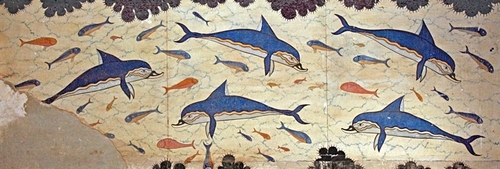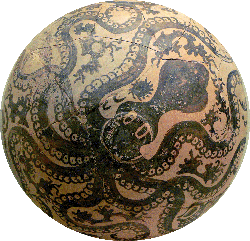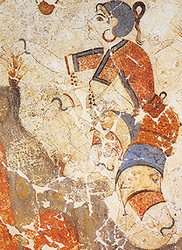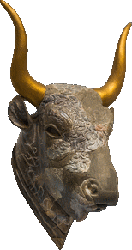THERA, CRETE AND ATLANTIS: IS THE MINOAN HYPOTHESIS VALID?

The destruction of Atlantis has been posited as having for its prototype the catastrophic eruption of the island of Santorini (Thera, modern Thira), previously regarded as having led to the end of the Minoan civilisation centred upon Crete.
There are, however, a number of serious difficulties in maintaining this notion.
Dendrochronology and radiocarbon dating evidence suggest that it occurred in around 1628 BC, whilst Egyptological evidence suggests that the decline of Crete as a major power may have occurred during the 18th dynasty at some point after 1450 BC, based to some extent on the chronology of the use of the term Keftiu, especially in relation to the weakening of Minoan society by the eruption as a possible trigger for incursions onto the island by mainland Greeks.

MINOAN CRETE
The Minoan civilisation, centred upon the large Aegean island of Crete, was a Bronze Age culture which, from around the turn of the second millennium BC, was centred upon a number of palatial complexes, of which the best known are Knossos and Phaistos.
The Minoans, who take their name from the powerful Cretan ruler Minos of later Greek mythology, were heavily involved in the complex trade networks of the time.
THERA
The volcanic island of Thera (also known as Santorini), located between Crete and the Aegean coast of Anatolia, was, in the early second millennium BC, home to the thriving town of Akrotiri.
Originally part of the Cycladic cultural complex, Akrotiri became increasingly influenced by the Minoan civilisation during this period. The town was abandoned after the devastating eruption of the volcano upon which it was built some time around 1600 BC.
KING MINOS
The Minoan civilisation, especially in its latest, Mycenaean-controlled phase, is the logical wellspring for later Greek stories of a king (or several kings) known as Minos, best known for being the proud owner of the labyrinth, in which dwelt his monstrous stepson the Minotaur until the death of this bull-headed fellow at the hands of the vengeful Athenian hero Theseus.
While the Athenians - who remembered being under gruesome tribute to Minos - were not his biggest fans (as Socrates points out in the possible Platonic dialogue bearing his name), Minos - a son of Zeus - also features as one of the judges of the dead, and it is in such a role that he is known to Plato [see Gorgias 524a].
THE MINOAN THALASSOCRACY

Thucydides does mention Crete as a significant sea power under Minos' rule, crediting Minos as "the first person known to us by tradition as having established a navy" [1.1.4], with which he rid the Aegean of pirates and settled the Cyclades, facilitating communication [1.1.8] and the economic growth of his kingdom.
Interestingly, Thucydides' pirates included Phoenicians, besides Carians (the historical Carians were a people of southwestern Asia Minor, whose territory included regions close to Herodotus' birthplace Halicarnassus).
Minos - who, as a son of Zeus, can hardly be described as one whose "portion of divinity [...] was now becoming faint and weak through being ofttimes blended with a large measure of mortality" [Crit. 121a] - was also well-regarded by Plato, for whom he was a significant lawgiver and, post-mortem, is found in his familiar guise as a judge of the dead, with Plato making him arbiter among the three judges, holding a casting vote on the fates of the souls of the deceased [Gorgias 524a].

It would, perhaps be easier making a case for an indirect transmission for the account of the Santorini disaster via Egypt. Egyptian records name a people they term Keftiu, who were juxtaposed with the "western land" in a "Hymn of Victory" from the reign of Thutmose III [Ancient Records 2.659]. The majority of references to the Keftiu appear in and around the time of Thutmose III, who is usually placed in the 15th century BC.
Earlier records of contact between Crete and the Near East exist: the Mari archives contain records which give a place name Kap-ta-ra and Hyksos-period palace decoration from Avaris appear to be Minoan in origin, leading to suggestions of a Minoan presence on the site during the period. Minoan wall-paintings have also been found dating to the time of Thutmose III and his successor Amenhotep II.
Unfortunately, no extant records remain which indicate a violent end to the Minoan civilisation within Egypt: the Keftiu simply disappear from history. Additionally, the evidence suggesting that the major phase of the Santorini conflagration took place earlier than previously assumed decouples this event from the terminal period of Minoan grandeur, thus suggesting that the Minoans survived the cataclysm - indeed thrived in its aftermath. With this in mind, the connection between the Keftiu (if the assumption that they were the Minoan Cretans is correct) and Atlantis must be rejected.
CLASSICAL KNOWLEDGE OF THE THERA EVENT(S)

One of the major issues with the "Minoan Atlantis" hypothesis is that surviving Greek sources betray absolutely no knowledge of the conflagration. Herodotus mentions the settlement of Thera by Theras, a prince from the line of Cadmus at Thebes who threw his lot in with the invading Heraclids [4.147]. According to Herodotus, the island, which was formerly known as Calliste, had been home to a Phoenician colony descended from a certain Membliarus for eight generations.
The name Calliste came from a daughter of Triton who was transported into the Aegean from Lake Tritonis by the Argonaut Euphemus in the form of a clod of earth which, being washed overboard, became the island.
Pindar knows the tale of the clod but it is left to Apollonius of Rhodes to connect it with the island of Calliste, which Euphemus "threw [...] into the depths of the sea, and there grew up from it an island called Calliste, the sacred Nurse of his descendants" [4.1734-1764: 4.1551-1561 describes how Triton, in the guise of Eurypylus son of Poseidon, gave it to them].
Taken together, there appears to be little room for the Santorini eruption in Greek historiography.
The notion of a "clod" (βῶλος) of earth thrown into the sea and growing into an island could be interpreted as redolent of a newly formed volcanic island - and, indeed, this has been a factor at Thera. Ian Thornton writes: -
Though all of the islands Thornton describes appeared after Plato and Apollonius's floruit, it is not difficult to imagine the process occurring earlier too, though there is no evidence.
Additionally, Calliste is identified with Thera, an island large enough to support a population and, as such, any suggestion that it was an ephemeral volcanic cone is highly unlikely. As such, it is difficult to state with certainty that Plato knew anything at all about the Bronze Age eruption of Santorini.
Additionally, the effects of the cataclysm on Minoan civilisation, whilst considerable, were not necessarily terminal. S.L. Budin has this to say: -
"BIGGER" OR "BETWEEN"?
One possible support for an identification of Crete, Thera or the Minoans in general with the island of Atlas in the dialogues with some scholarly support is a potential misreading of the passages at Tim. 24e and Crit. 108e ("an island [which was] larger than Libya and Asia").
Two questions arise, particularly with regards to the Greek term μείζων ("larger," else "greater").
The first suggests that rather than stating that the island Atlantis was larger than these two landmasses combined, the term refers to power, meaning that Atlantis was more powerful militarily than these countries. This writer offers only scepticism with regards to this: it seems clear that the phrase refers to the geography of these lands.
A second suggestion posits that μείζων is, in fact, an error, with the text intending to suggest that Atlantis lay μέσος, μέσον ("between") Asia and Libya. Given that Libya refers to all of the African lands west of Egypt and that Asia may mean no more than all or a part of Anatolia - i.e. "Asia Minor" (though Plato associates Asia with the Persian empire) - then Crete would seem a prime candidate during its Bronze Age heyday.
Other suggestions in this instance would be the other Mediterranean islands, while Diego Ratti's suggestion of the Hyksos capital Avaris in the Nile delta would be, to say the least, highly unlikely - particularly given that one of the major features of Plato's tale is that Egypt was somehow immune to cyclical disasters such as that which put paid to Atlantis and its Athenian nemesis.
Either way, this emendation doesn't recommend itself given that Plato quite clearly places Atlantis within the Atlantic Ocean.
Nice try, as they say, but nothing in the way of Cuba's finest.
